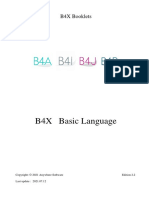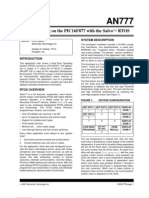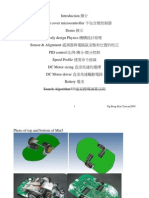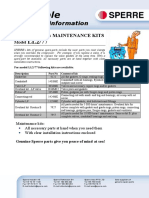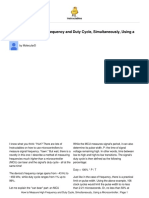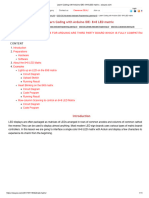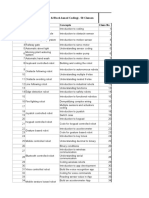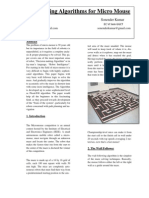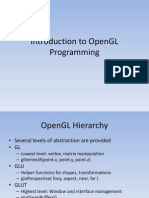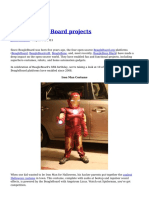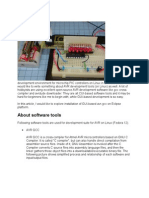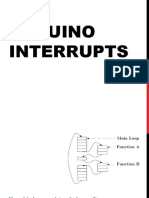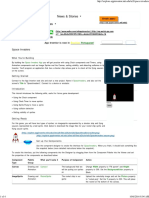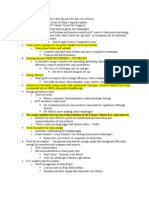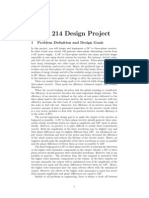0 ratings0% found this document useful (0 votes)
94 viewsMaze Solver 2
Maze Solver 2
Uploaded by
vsalaiselvam3553This program uses an algorithm to solve any maze by always moving left when possible. It employs the JB instruction to check specific bit locations that indicate the presence of walls and cheese. The program assigns symbols like MoveLeft and Cheese to make the code more readable. It checks the bit locations in P1, moves in the appropriate direction if a wall is not present, and gets stuck if surrounded on all sides.
Copyright:
© All Rights Reserved
Available Formats
Download as TXT, PDF, TXT or read online from Scribd
Maze Solver 2
Maze Solver 2
Uploaded by
vsalaiselvam35530 ratings0% found this document useful (0 votes)
94 views2 pagesThis program uses an algorithm to solve any maze by always moving left when possible. It employs the JB instruction to check specific bit locations that indicate the presence of walls and cheese. The program assigns symbols like MoveLeft and Cheese to make the code more readable. It checks the bit locations in P1, moves in the appropriate direction if a wall is not present, and gets stuck if surrounded on all sides.
Original Description:
maze
Copyright
© © All Rights Reserved
Available Formats
TXT, PDF, TXT or read online from Scribd
Share this document
Did you find this document useful?
Is this content inappropriate?
This program uses an algorithm to solve any maze by always moving left when possible. It employs the JB instruction to check specific bit locations that indicate the presence of walls and cheese. The program assigns symbols like MoveLeft and Cheese to make the code more readable. It checks the bit locations in P1, moves in the appropriate direction if a wall is not present, and gets stuck if surrounded on all sides.
Copyright:
© All Rights Reserved
Available Formats
Download as TXT, PDF, TXT or read online from Scribd
Download as txt, pdf, or txt
0 ratings0% found this document useful (0 votes)
94 views2 pagesMaze Solver 2
Maze Solver 2
Uploaded by
vsalaiselvam3553This program uses an algorithm to solve any maze by always moving left when possible. It employs the JB instruction to check specific bit locations that indicate the presence of walls and cheese. The program assigns symbols like MoveLeft and Cheese to make the code more readable. It checks the bit locations in P1, moves in the appropriate direction if a wall is not present, and gets stuck if surrounded on all sides.
Copyright:
© All Rights Reserved
Available Formats
Download as TXT, PDF, TXT or read online from Scribd
Download as txt, pdf, or txt
You are on page 1of 2
; This 8051 program solves any maze.
; It employs the algorithm:
; 1) If you are on the cheese, then stay there.
; 2) Otherwise, if you can move left, then move left.
; 3) Otherwise, if you can move forward, then move forward.
; 4) Otherwise, if you can move right, then move right.
; 5) Otherwise, if you can move backwards, then move backwards.
; 6) Otherwise, complain about being placed in a defective maze.
;
;
;
;
;
;
;
This algorithm is what you would do if you stuck out your
left hand and walked the maze by always keeping your left
hand pressed against the left wall. As long as the walls
are no wider than your outstretched hands, this simple algorithm
guarantees that you will eventually explore the entire maze
and hence find the cheese (obviously, this algorithm will
not explore the center of a large cavernous area).
;
;
;
;
;
;
;
;
;
;
;
;
;
;
;
;
;
;
;
Whereas my MazeSolver.txt program employs the ANL and CJNE
instructions, this MazeSolver2.txt program employs the JB
instruction. The operand specified with the JB instruction
must either be a bit located in the "bit addressable data memory"
(which is that section of data memory from address 0x20 thru 0x2F)
or else a bit within one of the bit addressable special function
registers (these are the special function registers whose hex
address ends in 0, such as the P0 register with a hex address of
0x80). There are 128 bits within the 16 byte section of
bit addressable data memory and these are given the bit
addresses from 0 to 0x7F = 127. There are another 128
bit addresses ranging from 128 = 0x80 to 0xFF = 255
which correspond to bits in the bit-addressable SFR registers.
The easiest way to refer to a bit in the bit-addressable
section of data memory is to use notation such as:
JB 0x20.3, Ahead
The easiest way to refer to a bit in a bit-addressable special
function register is to use notation such as:
JB P0.3, Ahead
;
;
;
;
;
;
;
There are potentially 4 directions we can move: left, right,
forwards, and backwards.
To move left we write 0x00 to P0.
"
forward "
0x01 "
"
right
"
0x02 "
"
backward "
0x03 "
Writing any other value to P0 causes no motion.
; In order to avoid having these 4 numbers "hard coded" in
; our 8051 program, we employ the EQU assembler directive
; to assign more convenient symbols for these values:
MoveLeft
MoveForward
MoveRight
MoveBackward
;
;
;
;
;
;
EQU
EQU
EQU
EQU
0x00
0x01
0x02
0x03
Any of these directions might be blocked by a wall.
To learn which walls currently surround us we read from P1.
If one of the following bits in P1 is a 1 then there is a wall
in that direction:
MSBit 7
6
5
4
3
2
1
0 LSBit
cheese not not not rear right front left
used used used wall
wall
wall
wall
; In order to avoid having the bit locations "hard coded" in
; our 8051 program, we employ the EQU assembler directive
; to assign more convenient symbols for these values:
LeftWall
FrontWall
RightWall
RearWall
Cheese
EQU
EQU
EQU
EQU
EQU
0
1
2
3
7
Loop:
JNB P1.Cheese, Move ; check for the presence of cheese
Eat:
SJMP Eat
; don't move, we're on the cheese
Move:
JNB P1.LeftWall, NoLeftWall
; check for presence of left wall
JNB P1.FrontWall, NoFrontWall ; check for presence of front wall
JNB P1.RightWall, NoRightWall ; check for presence of right wall
JNB P1.RearWall, NoRearWall
; check for presence of rear wall
; If we get to here we are trapped by 4 walls and hence the
; maze was defective!
Trapped: SJMP Trapped
NoRearWall:
MOV P0,#MoveBackward
LJMP Loop
NoRightWall:
MOV P0,#MoveRight
LJMP Loop
NoFrontWall:
MOV P0,#MoveForward
LJMP Loop
NoLeftWall:
MOV P0,#MoveLeft
LJMP Loop
You might also like
- B4xbasiclanguagev2 2Document143 pagesB4xbasiclanguagev2 2Jorge SolerNo ratings yet
- Convert Optical Mouse Into Arduino Web CameraDocument8 pagesConvert Optical Mouse Into Arduino Web CameraJorge Pablo Ordemar Cisneros100% (2)
- nuBuilderForte UserGuide PDFDocument91 pagesnuBuilderForte UserGuide PDFmatalab100% (1)
- MultiTask On PIC16F877ADocument24 pagesMultiTask On PIC16F877Amadyak100% (1)
- GRBL Commands v1.1 2 PDFDocument14 pagesGRBL Commands v1.1 2 PDFYousef M. YazjiNo ratings yet
- JSF++ AV Coding Standard NLDocument36 pagesJSF++ AV Coding Standard NLWen-Yu ChenNo ratings yet
- Micromouse PresentationDocument49 pagesMicromouse PresentationnitinakkNo ratings yet
- Sperre LL2 77 CompressorDocument1 pageSperre LL2 77 CompressorTanay ShahNo ratings yet
- How To Measure High Frequency and Duty Cycle SimulDocument9 pagesHow To Measure High Frequency and Duty Cycle SimulHafiz khanNo ratings yet
- Sqlite Database: B4X BookletsDocument67 pagesSqlite Database: B4X BookletsSaleh alshabwaniNo ratings yet
- Data - Structures Using C PDFDocument122 pagesData - Structures Using C PDFjegadeeswarNo ratings yet
- Learn Coding With Arduino IDE - 8×8 LED MatrixDocument11 pagesLearn Coding With Arduino IDE - 8×8 LED Matrixjerelincango.13No ratings yet
- How To Implement STM32 To B4RDocument8 pagesHow To Implement STM32 To B4RURS FreelancingNo ratings yet
- Robotics Explorer (150 Classes) - Skyfi LabsDocument6 pagesRobotics Explorer (150 Classes) - Skyfi LabsDivya KNo ratings yet
- Micro MouseDocument17 pagesMicro MouseFarshad yazdiNo ratings yet
- Exposed Brickwork PDFDocument2 pagesExposed Brickwork PDFEdwardNo ratings yet
- STM32 Training 12W06 1V0Document73 pagesSTM32 Training 12W06 1V0Oussama Riahi ChNo ratings yet
- Maze Solving AlgorithmsDocument7 pagesMaze Solving AlgorithmssurojitguhaNo ratings yet
- Map Creation and Position Correction For An Off The ShelfDocument119 pagesMap Creation and Position Correction For An Off The Shelfapi-276370950% (1)
- Tutorial 16 - 128x64 ST7920 Graphical - Dot-Matrix SPI LCDDocument8 pagesTutorial 16 - 128x64 ST7920 Graphical - Dot-Matrix SPI LCDCarlos Rojas TezenNo ratings yet
- Study Arduino Interfacing With LCD 7-Seg Serial CommDocument11 pagesStudy Arduino Interfacing With LCD 7-Seg Serial CommDeepak KumbharNo ratings yet
- MicromouseDocument17 pagesMicromousepiyushji125No ratings yet
- G100 Set Up Guide Rev.1 9-19-07Document34 pagesG100 Set Up Guide Rev.1 9-19-07Milton MarinNo ratings yet
- 16feb18 Micromouse WebinarDocument58 pages16feb18 Micromouse WebinarUmairNo ratings yet
- Bios HDocument4 pagesBios HAlberto HernandezNo ratings yet
- Arduino 8×8 LED MatrixDocument6 pagesArduino 8×8 LED MatrixYassir ButtNo ratings yet
- LaboratoryManualForEmbeddedControllers PDFDocument96 pagesLaboratoryManualForEmbeddedControllers PDFeng_refaatNo ratings yet
- Assembly Programming Tutorial: What Is Assembly Language?Document75 pagesAssembly Programming Tutorial: What Is Assembly Language?Bhagya Gaddam100% (1)
- Frequently Asked Questions GRBL Wiki GitHubDocument7 pagesFrequently Asked Questions GRBL Wiki GitHubMarky MaypoNo ratings yet
- Home Automation Using STM32 and Bluetooth ModuleDocument21 pagesHome Automation Using STM32 and Bluetooth ModuleKhalid0% (1)
- Arduino Based Optical TachometerDocument12 pagesArduino Based Optical TachometerMarius DanilaNo ratings yet
- Line Follower Robot Final PPT 1Document16 pagesLine Follower Robot Final PPT 1harshil mangeNo ratings yet
- Lab6 Phase Locked LoopsDocument20 pagesLab6 Phase Locked Loopsuitce2011No ratings yet
- War Field Spying Robot With Night Vision Wireless Camera by Android ApplicationsDocument32 pagesWar Field Spying Robot With Night Vision Wireless Camera by Android ApplicationsharshithaNo ratings yet
- Arduino The Object WayDocument23 pagesArduino The Object Wayopenjavier5208No ratings yet
- Special Edition Using Visual C++ 6.0Document464 pagesSpecial Edition Using Visual C++ 6.0Tony AntonioNo ratings yet
- Raspberry Pi Pico 200Khz Digital OscilloscopeDocument15 pagesRaspberry Pi Pico 200Khz Digital OscilloscopeBenjamin LOMUTONo ratings yet
- Contiki SlidesDocument90 pagesContiki SlidesledoantuanNo ratings yet
- Distance Measurement System Project Report - Amit BarDocument32 pagesDistance Measurement System Project Report - Amit BarAmit Bar100% (1)
- Getting Started With Stm32f103c8 With MbedSTLink V PDFDocument6 pagesGetting Started With Stm32f103c8 With MbedSTLink V PDFkyaw phone htetNo ratings yet
- Problem Solving With Algorithms and Data Structures Using Python - Problem Solving With Algorithms and Data StructuresDocument6 pagesProblem Solving With Algorithms and Data Structures Using Python - Problem Solving With Algorithms and Data StructuresErr33No ratings yet
- dsPIC Microcontroller PDFDocument19 pagesdsPIC Microcontroller PDFSỹ RonNo ratings yet
- How Is Arduino Uno Different From Other Available Microcontrollers?Document25 pagesHow Is Arduino Uno Different From Other Available Microcontrollers?Raghotham RaoNo ratings yet
- Arm ProcessorDocument9 pagesArm ProcessorRahul AgarwalNo ratings yet
- Introduction To OpenGL ProgrammingDocument20 pagesIntroduction To OpenGL ProgrammingAyush MaheshwariNo ratings yet
- Morse Code Decoder CircuitDocument4 pagesMorse Code Decoder CircuitPrasanna KumarNo ratings yet
- A Low Cost Indoor Mapping Robot Based On Tinyslam AlgorithmDocument4 pagesA Low Cost Indoor Mapping Robot Based On Tinyslam AlgorithmSoli UdinNo ratings yet
- Wireless Sensor Networks: Security, Attacks and ChallengesDocument13 pagesWireless Sensor Networks: Security, Attacks and ChallengesPradip KumarNo ratings yet
- Top 10 BeagleBoard ProjectsDocument8 pagesTop 10 BeagleBoard ProjectsraakshasuduNo ratings yet
- Arduino Programming and Hardware Fundamentals With Hackster - Online Engineering CoursesDocument1 pageArduino Programming and Hardware Fundamentals With Hackster - Online Engineering CoursesMohamed AlkharashyNo ratings yet
- About Software ToolsDocument40 pagesAbout Software ToolsFurqon Madaz XskaMaticNo ratings yet
- Using GRBL GRBL Wiki GitHubDocument8 pagesUsing GRBL GRBL Wiki GitHubMarky Maypo100% (1)
- Dokumen - Pub Algorithm Design TechniquesDocument555 pagesDokumen - Pub Algorithm Design TechniquesAdil SadikiNo ratings yet
- stm32 Education Step2Document11 pagesstm32 Education Step2Nanang Roni WibowoNo ratings yet
- 52 Tips & Tricks To Boost .NET PerformanceDocument66 pages52 Tips & Tricks To Boost .NET Performancev_doina20023873No ratings yet
- Embedded BookletDocument16 pagesEmbedded BookletpratikgoleNo ratings yet
- ESP32 Based Webserver For Text To Speech (TTS) ConversionDocument10 pagesESP32 Based Webserver For Text To Speech (TTS) ConversionCahyaDsnNo ratings yet
- Arduino - InterruptsDocument58 pagesArduino - Interrupts18018022 I Made Ngurah Chandra Marutha100% (2)
- Space Invaders - Explore MIT App InventorDocument4 pagesSpace Invaders - Explore MIT App InventorAriyanto AriNo ratings yet
- Draw Sine WaveDocument1 pageDraw Sine Wavevsalaiselvam3553No ratings yet
- Increment Forever 2Document1 pageIncrement Forever 2vsalaiselvam3553No ratings yet
- Bad SyntaxDocument1 pageBad Syntaxvsalaiselvam3553No ratings yet
- Draw SpirographDocument2 pagesDraw Spirographvsalaiselvam3553No ratings yet
- Maze SolverDocument2 pagesMaze Solvervsalaiselvam3553No ratings yet
- Train 2Document2 pagesTrain 2vsalaiselvam3553No ratings yet
- Your Name 3Document2 pagesYour Name 3vsalaiselvam3553No ratings yet
- ProtocolDocument19 pagesProtocolAlin StelianNo ratings yet
- Manish PHD Thesis PDF CD PDFDocument158 pagesManish PHD Thesis PDF CD PDFNitin Vinay KhareNo ratings yet
- 2010 Udla Show House BookletDocument24 pages2010 Udla Show House Booklettonya@philimina.comNo ratings yet
- Hot, Flat, and Crowded Outline (11, 12)Document6 pagesHot, Flat, and Crowded Outline (11, 12)Stephanie DofitasNo ratings yet
- SAP PM ReportsDocument18 pagesSAP PM ReportsRehan KhanNo ratings yet
- VulcanDocument8 pagesVulcanalpianusNo ratings yet
- Exhibitors List - Malaysia Gifts Fair 2019 - GiftsDocument4 pagesExhibitors List - Malaysia Gifts Fair 2019 - GiftsMimpi GraphicsNo ratings yet
- CORKEN Sliding Vane LPG PDFDocument40 pagesCORKEN Sliding Vane LPG PDFJhon MarzanaNo ratings yet
- EE 214 Design Project: 1 Problem Definition and Design GoalsDocument5 pagesEE 214 Design Project: 1 Problem Definition and Design GoalsSeda ToyNo ratings yet
- NEW SILVER 5.5-10 230-400-50-60 20-07-2017 1127340125 ING PartsDocument15 pagesNEW SILVER 5.5-10 230-400-50-60 20-07-2017 1127340125 ING PartsCarlos Ferreira100% (1)
- Singla PPT On MpfiDocument19 pagesSingla PPT On MpfiRohit SinglaNo ratings yet
- Enplug DirectionsDocument2 pagesEnplug DirectionsjtNo ratings yet
- 627 GeoProducts GeocellCompr 030712Document8 pages627 GeoProducts GeocellCompr 030712Juan Carlos Jaramillo GuerreroNo ratings yet
- 12 Solutions For Fixing Common TEVDocument7 pages12 Solutions For Fixing Common TEVRahul ChandrawarNo ratings yet
- RRKE0114 Roorke Deefence COLonyDocument2 pagesRRKE0114 Roorke Deefence COLonyPoornima SinghNo ratings yet
- Planta de Tratamiento de Agua Esquema Eléctrico Del Sistema de Automatización. SidorDocument279 pagesPlanta de Tratamiento de Agua Esquema Eléctrico Del Sistema de Automatización. SidorEdgar MartinezzNo ratings yet
- Bernabas DuctDocument81 pagesBernabas Ductbern14No ratings yet
- 030a 202a enDocument60 pages030a 202a enSunthron Somchai0% (1)
- 2 1 SecoGear PDFDocument64 pages2 1 SecoGear PDFMuhammad NomanNo ratings yet
- A 8051 7 MCS 51中斷結構Document46 pagesA 8051 7 MCS 51中斷結構Brian Yeh100% (1)
- T8400C and T8401C Electronic Thermostats: Mercury Notice CautionDocument6 pagesT8400C and T8401C Electronic Thermostats: Mercury Notice CautionEduardo Jahnke RojasNo ratings yet
- E50 en Tcd210020ab 20220321 Inst WDocument1 pageE50 en Tcd210020ab 20220321 Inst Wesau hernandezNo ratings yet
- Extron Sw2 Usb PDFDocument2 pagesExtron Sw2 Usb PDFRuthNo ratings yet
- Hathway BillDocument1 pageHathway BillSanthoshkumar.Jayaram (CareerNet)No ratings yet
- SLB Dowel CementPlugs PDFDocument27 pagesSLB Dowel CementPlugs PDFMohamed MahmoudNo ratings yet
- Conductive Anodic Filament (CAF)Document4 pagesConductive Anodic Filament (CAF)asamadh100% (1)
- hotmail@calcer_cloud (6)Document13 pageshotmail@calcer_cloud (6)marwan.chinwikl1111No ratings yet
- Know Your State Arihant - Download Free PDF - AshokaDocument773 pagesKnow Your State Arihant - Download Free PDF - Ashokasushil9319No ratings yet
- Embedded SystemDocument45 pagesEmbedded SystemVinayaga MoorthyNo ratings yet
